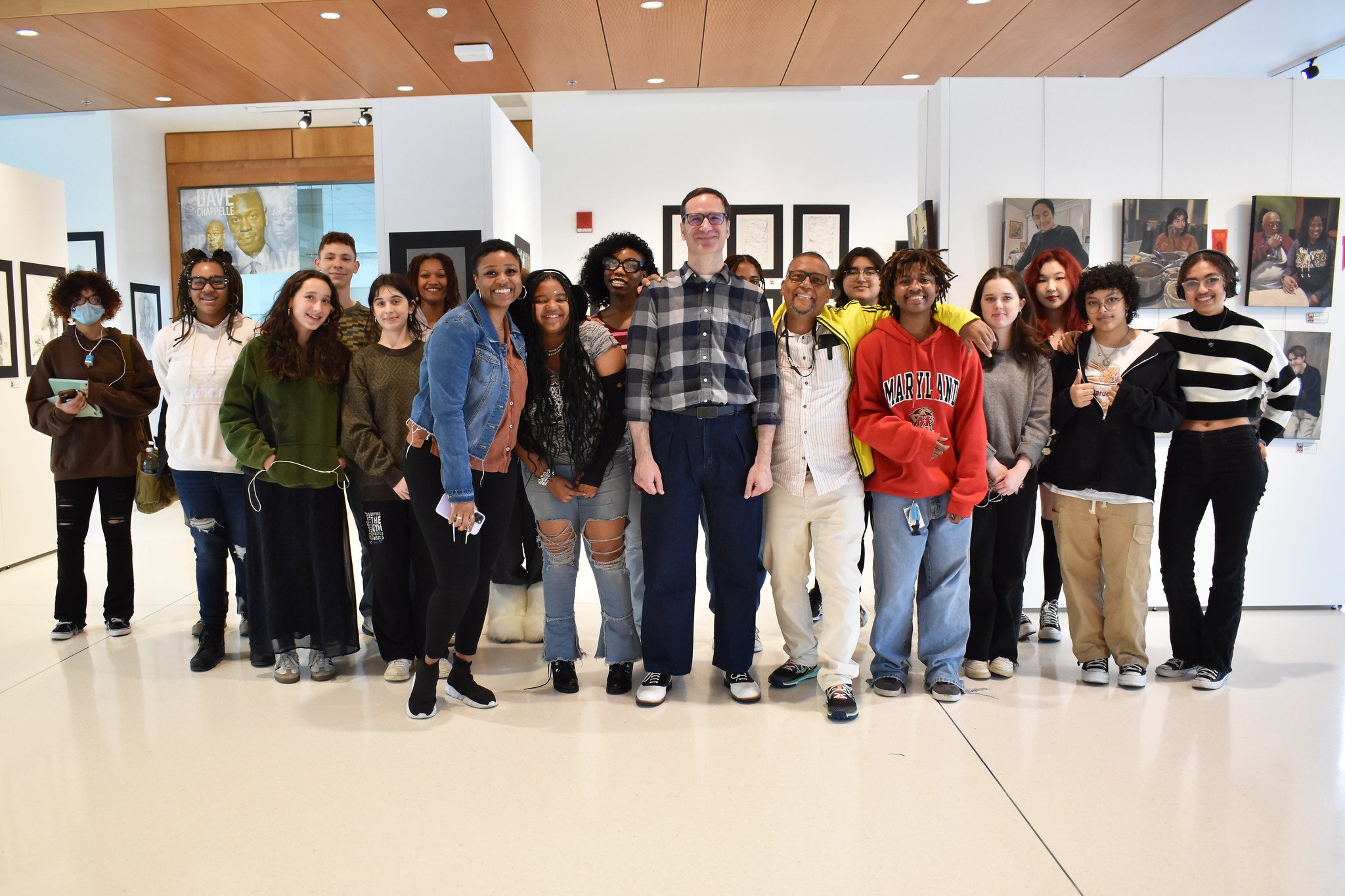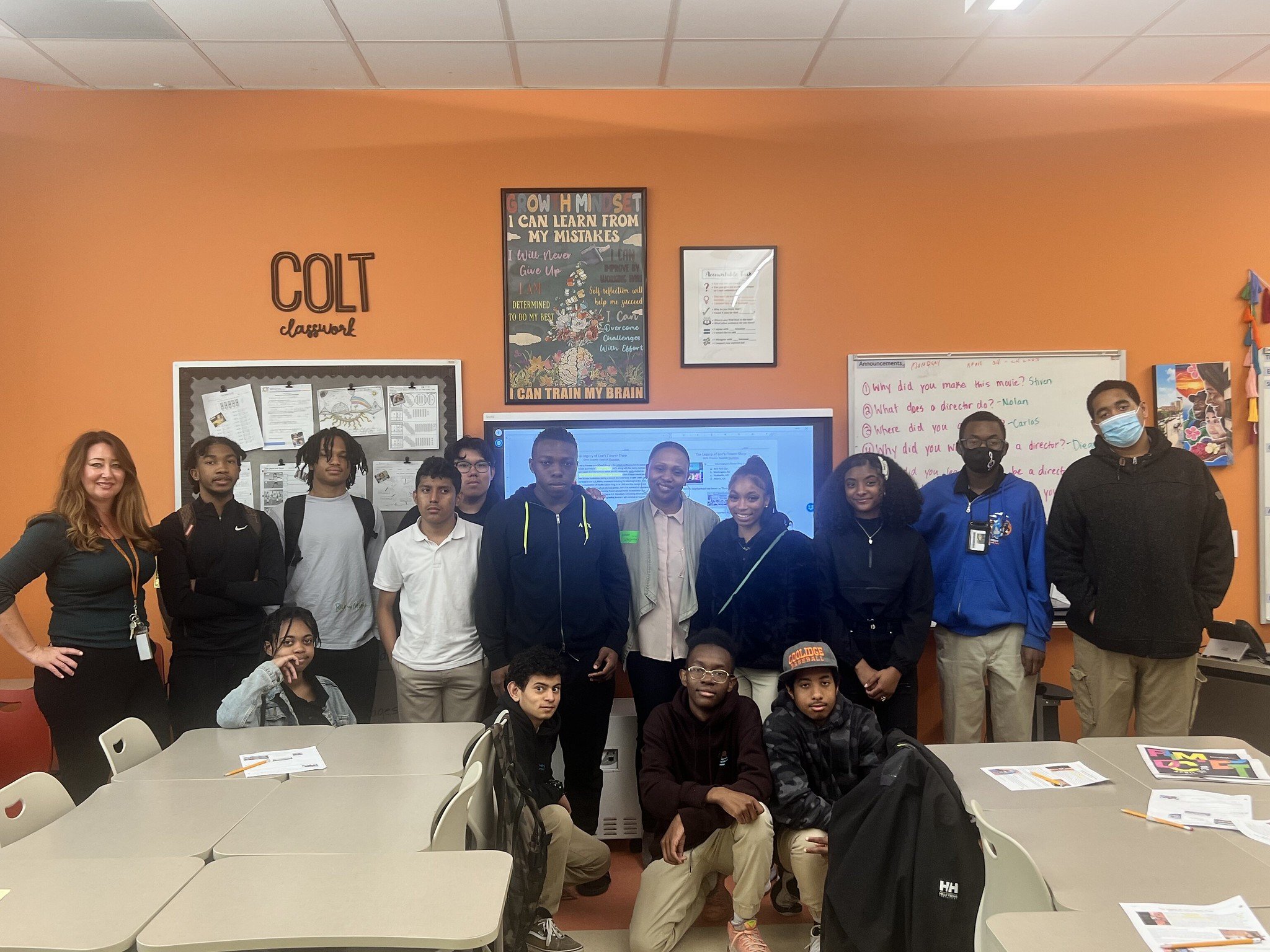Screentime That’s Good for Students and Classrooms: Filmfest 2023
In April 2023, Teaching for Change partnered with Filmfest DC: The Washington, DC, International Film Festival for a twelfth year to bring filmmakers into D.C. classrooms to share some of their films.
Students learned about filmmaking and social justice issues from viewing the films and participating in discussions with the filmmakers. (Read about prior year visits.)
Las Abogadas Classroom Visits
E.L. Haynes
“It’s really hard to change the whole world, but it’s not really hard to change the whole world for one person.” — Rebecca
Both Topher Kandik and Madison Dalton’s classes at E.L. Haynes PCS were moved by the work and stories Rebecca Eichler and Lauren Seltzer brought with them during their visits.
Dalton, who is in her first year as a lead teacher at Haynes, was Kandik’s mentee last year while she was still studying to become a teacher. Dalton, who teaches a Race and Culture class, and Kandik, whose writing course is called Writing Home, both designed their course curricula to explore themes of migration and immigration, gentrification, binationalism, and how all these themes intersect.
With these themes as a guide, the high school students demonstrated their marked interests in the film’s subject matter and in the film industry itself and posed questions like:
How much money did it take to create the film?
Why did you decide to become an immigration lawyer?
How did you two meet?
What other documentaries have you made?
What other projects are you working on right now?
Where are you off to next for this film?
How did you choose the people to be featured in this film?
The filmmakers, too, had their own questions:
What instances of racism did you notice throughout the film?
What causes are you interested in?
Did the film inspire any action from you?
Who here is an immigrant or has family or friends who are immigrants?
Who here speaks a language other than English?
Town Destroyer Classroom Visit
School Without Walls
“We meant it as an indictment.” — Alan Snitow
For an hour, Kerry Sylvia’s 12th-grade students at School Without Walls engaged with the filmmakers for Town Destroyer with penetrating questions and insightful reflections, especially about public art and its place in public education. The students themselves were mired in their own discussion about their senior art mural and how to best capture their legacy message to subsequent classes at the school.
The students shared that they wanted to uplift literature from their childhood and high school years, but noted that there was conflict over which writers to celebrate and to what degree they would depict their impact. They asked, “Should we show the trials or the triumphs in their stories?”
Discussion that day was a civics experience, a history lesson, and an art class with conversation hitting on the tension that can exist between public art, public memory, and public education.
Themes they explored:
Making the distinction between propaganda and public art
Highlighting the contradictions of some founders and connections to the high school today
How meaning is inscribed and reinscribed to the murals with each generation
The impacts of local v. federal politics, and local v. national media
Legacy of Lee’s Flower Shop Classroom Visits
Coolidge HS
“Who will tell the story of old D.C. when everything is new?” — Kamilah Thurmon
This question inspired Thurmon to tell the story of Lee’s Flower Shop, the oldest continuously family-owned flower business in Washington, D.C. Students in Beth Sewell’s class discovered more about Thurmon’s inspiration for this film through an in-person visit. During this time, students asked Thurmon various questions, including inquiries about the role and responsibility of a director, her filmmaking process, her background and career trajectory, and ideas for her next film.
Students, particularly those in Coolidge’s mass media program, were extremely curious about Thurmon’s entry into the film industry and any insight she may have for those looking to break in. Thurmon reflected on her early career experiences and shared how her love for talking to people and telling stories people would not normally highlight has guided her work, especially the making of Legacy of Lee’s Flower Shop.
Sewell shared:
Not only did I learn about the Legacy of Lee's Flower Shop, but I reflected on the importance of the work that directors do in memorializing important institutions and time periods. [Because of this visit,] I will have my students arrange a visit to talk to a local Black business owner on U Street about their experiences, too. This was so impactful. Thank you!!!
Johnson Middle School
Mr. Haas’ 6th grade geography class was inquisitive and sharp as they spent time with Kamilah Thurmon. They transformed their classroom seating from partnered desks into an intimate circle, and broke out the Post-It noted questions they prepared to ask Thurmon about both the film and the shop.
Questions:
Can I have some flowers and get a job at Lee’s?
How long did it take to film the documentary, and how was it funded?
What do you think the impact Lee’s has on the community now?
What other projects are you working on right now?
How much money was spent to make the documentary?
What’s your favorite type of flower?
Haas mentioned that their discussion connects back to learning they did earlier in the school year about gentrification, the U Street Corridor, and the Black businesses that did and still do exist there. One student remembered their study of Black wealth and banking and exclaimed that they remembered Industrial Bank being a part of their learning and was excited to see it referenced in the film.
D.C. International School
Thurmon joined a Digital Video Production class at D.C. International School to discuss Legacy of Lee’s Flower Shop with Ashley Porter’s 9th through 11th grade students. During the visit, students noted the importance of African American entrepreneurship and how impressed they were that the business has continued to successfully operate since 1945 under the ownership of a single family. Tied to that, students solemnly observed two times of civil unrest when the shop’s owners put a “Black owned business” sign in the window to protect it from being damaged in the uprisings of 1968 and 2020.
Students had several questions for Thurmon about the filmmaking process, both philosophical and technical. In response to the question of why she chose to make this documentary, Thurmon said that it grew out of discussions following her work creating a documentary on The Davis Center dance studio, also in Washington, D.C. When asked what her favorite part of the filmmaking process was, she told the students it was the interviews.
Thurmon shared that she spent two eight-hour-days filming interviews and visual shots, and that she had to go back once to reshoot for four hours. Students were surprised to learn that editing the film took almost one year, and that she only had a budget of between $30,000 - $40,000. The money was mostly used to pay for equipment, a director of photography, a sound engineer, and access to the Scurlock Photographic Studio archives. Thurmon told the students that she did not pay herself from the grants, and that this documentary was a “passion project” she made while working as a producer.
The students were overall impressed by the documentary and learning about the Black history of the U Street corridor in N.W., Washington, D.C. While only one student had been to the area, all of them seemed determined to make their way there in the near future to explore and learn more for themselves.
Meet Cute Classroom Visit
Duke Ellington School of the Arts
Sophomore and Junior Visual Arts students at Duke Ellington School of the Arts were treated to a three-hour visit and crash course in how to create an animated film from start to finish from Shawn Tilling, award-winning 3-D artist, professional cinematographer, and photographer, and director and producer of animated short films, including Meet Cute.
Tilling walked students through every step of the process, from coming up with an idea, tips for creating compelling characters, writing a “treatment” or working storyline with elements that will be rendered in 3D, using references to inform design choices, storyboarding, modeling characters, cinematography, and more. Tilling shared that Meet Cute was inspired by Buster Keaton and references from the 1920’s and shared some of the photographs that inspired the costumes for his characters. He explained that some of the background imagery was created from photographs, while other parts of thebackground were hand created as 3D objects or individually rigged as moveable objects, such as the tree leaves. Tilling also showed students the video reference he took of himself acting as the part of the characters to recreate in animated form.
At the end of the first visual arts class period, students were so engrossed in what they were learning that teachers Elana Casey and Mike Easton asked Tilling to stay through the second period to answer student questions. After a short break, Tilling explained that his current goal is to complete one short animation per year, and he then shared some of the current animation projects he is working on.
Students peppered Tilling with questions about his inspiration for becoming an animator, his mentors and inspiration, favorite animators, how he learned his craft, and more. Finally, Tilling and the students moved to the student art exhibit on display where Tilling viewed and critiqued student artwork and answered more questions about how to successfully develop and pursue your passions as an artist.
Black Fire Classroom Visit
E.L Haynes
Students in both Barrie Moorman’s and Nicole Addison’s classes were excited to sit down with Charvis Campbell, one of the filmmakers for Black Fire. Moorman’s 12th grade students, who are learning D.C. history this year, were enamored with Campbell. He initially shirked the idea that he is a filmmaker, but captivated the students in both classes by grounding them first in his career trajectory in high education in his early years, and then pursuing his doctorate and opening. Home Rule Records.
His lifelong love for music spurred him to open his shop, and the stories he came across from local musicians pushed him to tell the story of Jimmy Gray and Black Fire Records in this documentary short. While Campbell’s opening summary thoughts were engrossing and thought provoking enough, Moorman’s and Addison’s students also had other curiosities about him, the process of making the film, Gray, and Black Fire Records’ legacy.
Questions from students:
When did you realize that music was a political tool?
Was there a point in the filmmaking process when you knew the film would be a success?
Who were some of the people you wanted to interview to include, but just couldn’t?
How did go-go help your record-selling business?
What made you want to produce this film?
What advice do you have for aspiring filmmakers
Chevalier screening at Embassy of France
Hundreds of high school students from Bard High School Early College DC, E. L. Haynes PCS District of Columbia International School, Ron Brown College Preparatory High School, Roosevelt High School, and adult learners from Carlos Rosario International PCS all gathered at the Embassy of France to screen the film Chevalier. Tony Gittens welcomed the crowd in the embassy’s theater and a representative from the embassy’s team gave some brief remarks, as well. During the introductory remarks, Joseph Bologne’s historical significance — despite having quite a bit of his story erased or diminished — was made clear. Chevalier helped tell his story for modern audiences.
There was also a screening of Lowndes County and the Road to Black Power associated with the festival this year















